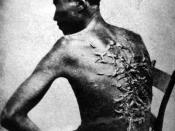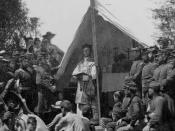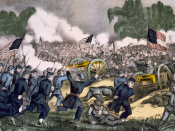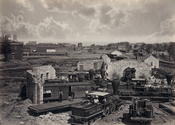Anne Firor Scott's The Southern Lady: From Pedestal to Politics 1830-1930 takes a social yet intellectual approach to the cultural image of the ideal southern woman. Scott analyzes the effect of this predominate image on women's behavior. Southern women are given a voice through Scott's writings. They clearly and vividly speak out about their feelings. These female southern heroes vividly and profoundly proclaim self-determination inspite of having to sometimes conform to social and cultural expectations. Scott relied upon diaries and letters, which had been preserved in manuscript collections across the United States, to analyze southern women's perceptions about their situation.
The southern woman was defined as a submissive individual whose reason for being was to "love, honor, obey, and occasionally amuse her husband." She was expected to raise "his children " and "manage his household." The central meaning of her life was family and motherhood. The everyday realities of life for a married woman were different from the expected image.
Women were often transformed from single, carefree, sought -after girls to responsible, submissive, plantation mistresses. They were led to believe that depraved women and men were the only sexual creatures; thus, they were supposedly incapable of erotic feelings.
Women were often uneducated, and when they began to voice their opinion concerning a need for education, most men disagreed with them. However some men did agree with them, but it was for the wrong reasons. Men believed that women should be educated in order to conduct female responsibilities more gracefully and effectively.
Men felt that women needed to develop their intellectual capacities to become better wives, mothers and companions.
The Civil War brought about a change for southern women. Since most men had been called to fight in the war, southern women had to assume greater responsibilities. They became manufacturers, managers, merchants, planters, and millers. They assumed responsibilities for maintaining, and if possible, increasing the food supply and for producing cotton and wool. They had to make clothes, flags, bandages, tents, and other things that were needed by soldiers. They were also responsible for overseeing the plantation, running the husband's business, and taking care of their children.
Anne Firor Scott does a terrific job describing the ideal southern woman, tracing the effect of the definition on how women behaved, describing the realities of southern women's lives, and describing the internal struggle of women who desired to free themselves from cultural expectations. She uses the diaries and letters that were preserved to her advantage because they support her theme, and they flow consistently with the text. Scott's book is very compelling and informative. Better yet, it is well organized, easy to understand, and well searched. (At least, she used her available resources very carefully and thoughtfully.) I would recommend this book to others because it is very informative and interesting. It is self-explanatory and worth every minute of your time. Not only does it identify what the ideal southern lady was, but it also details how southern women managed their lives inspite of having to be submissive.





